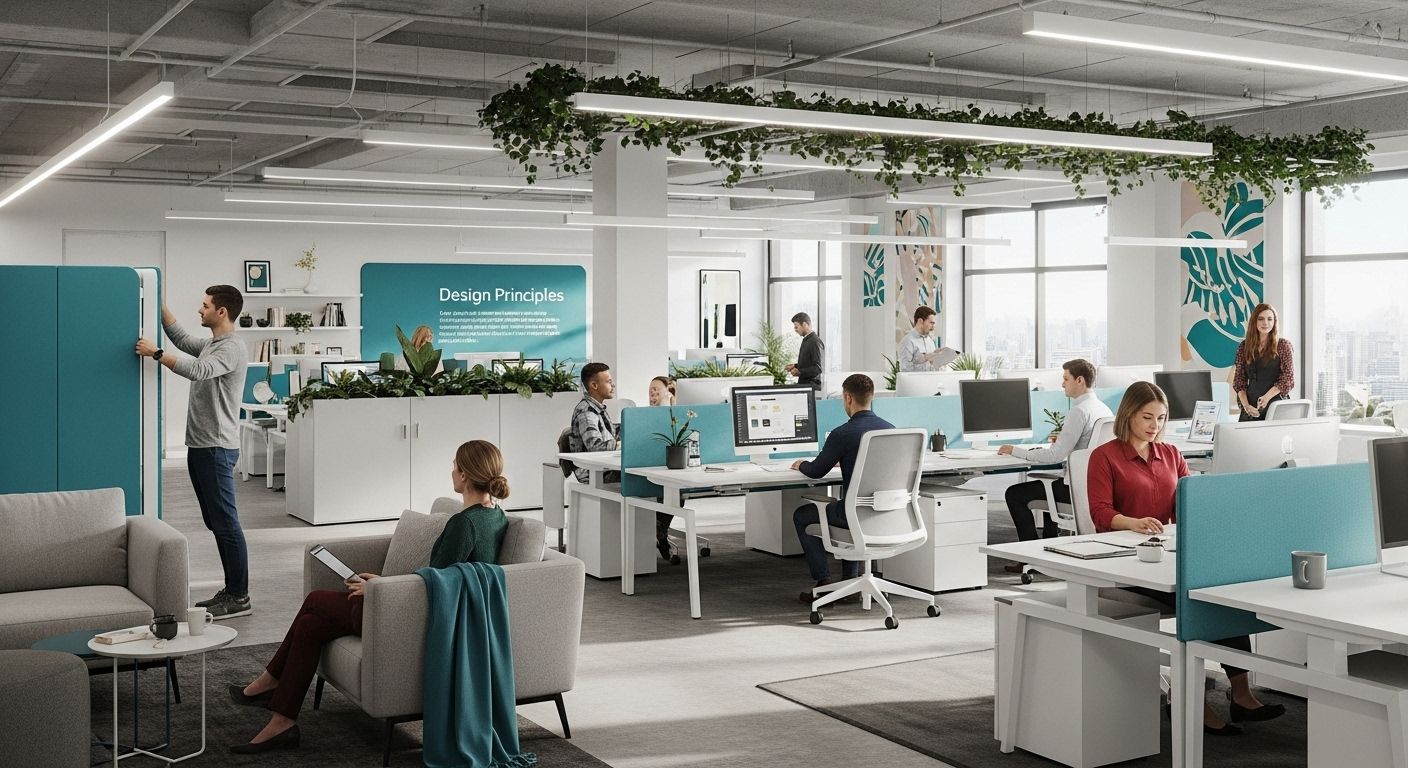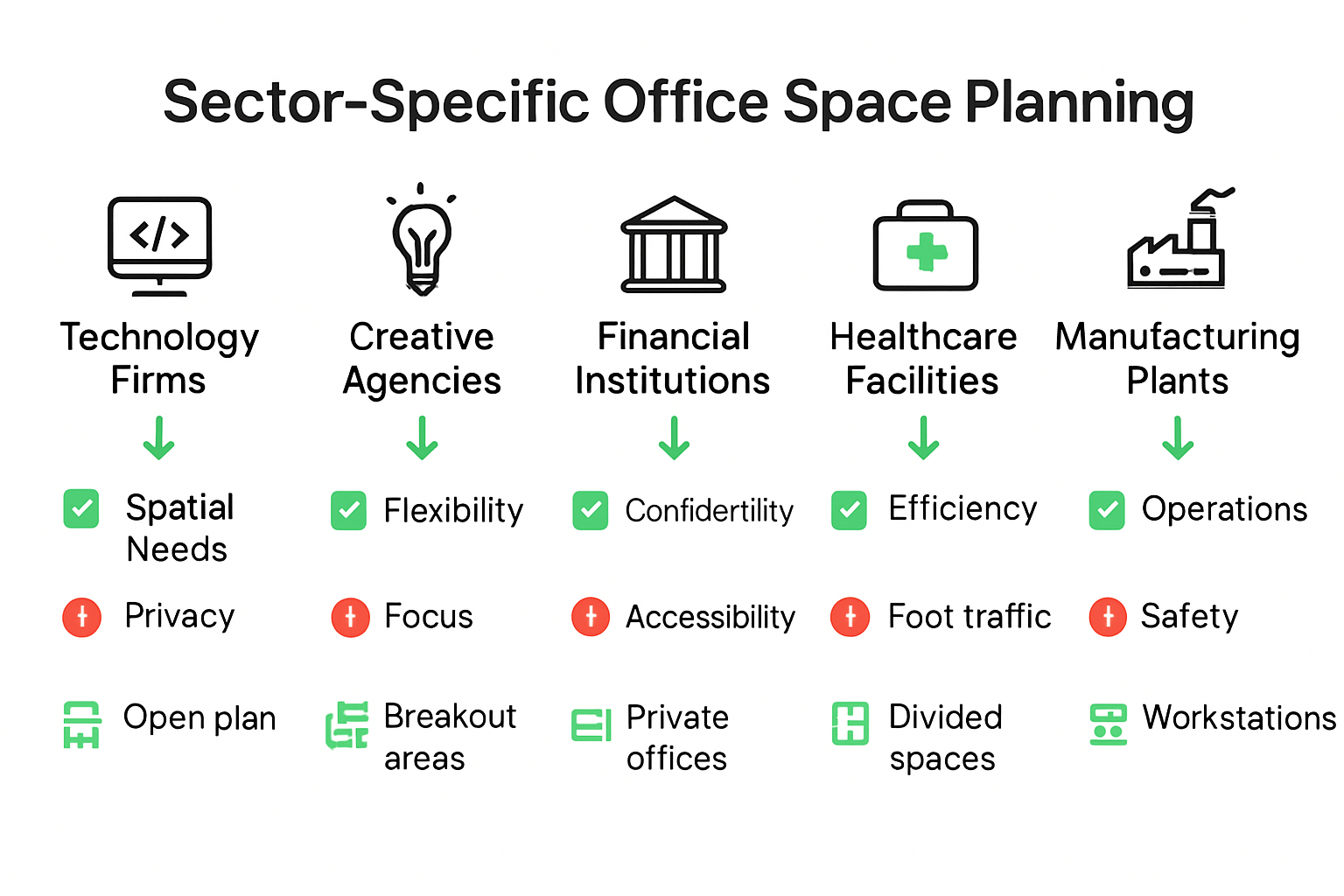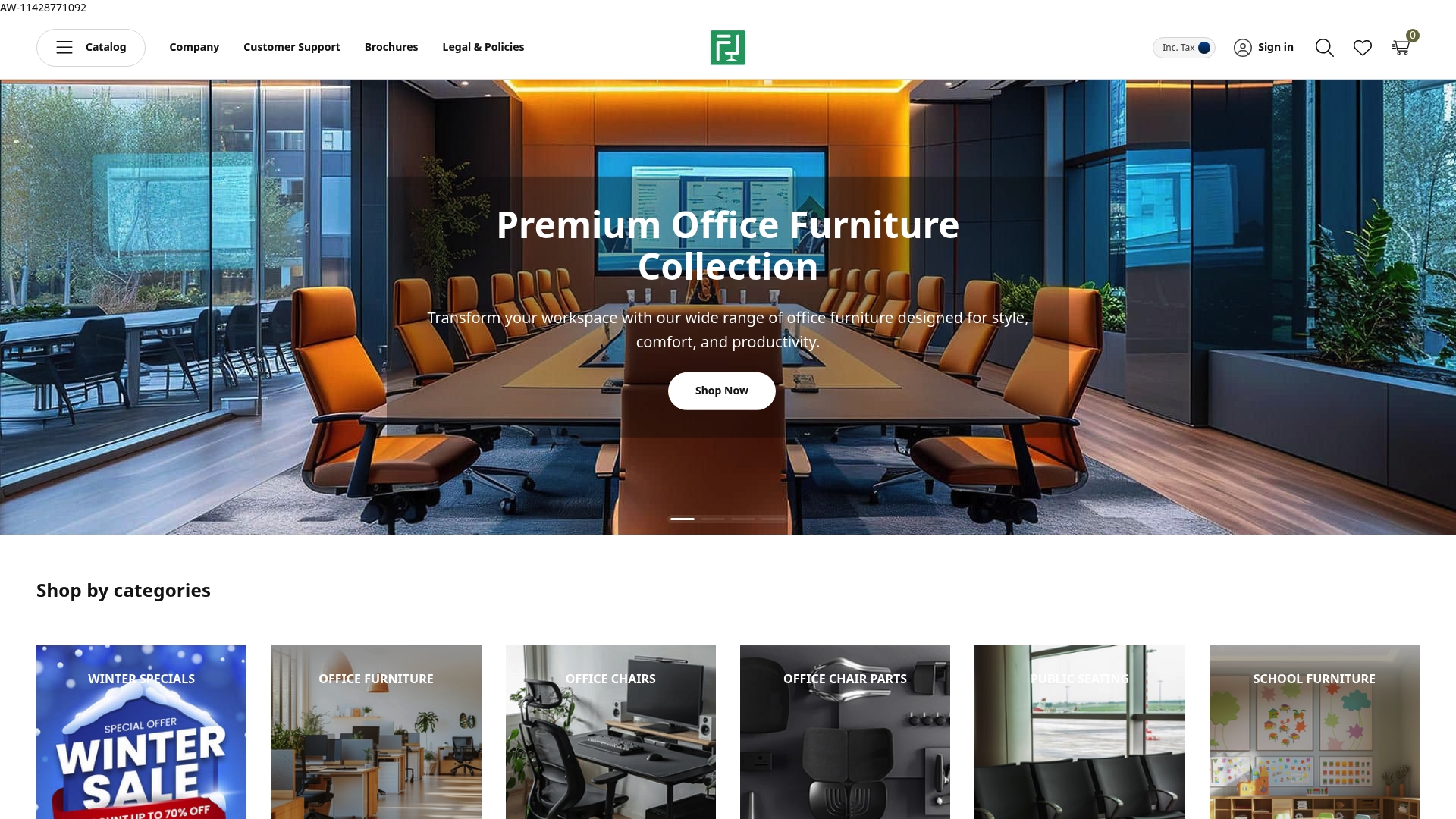Understanding Office Space Planning Basics for Businesses
Aug 21, 2025
Understanding Office Space Planning Basics for Businesses

Office space planning sounds like moving desks and hanging a few whiteboards. And yet, the way you arrange your office can crank up workplace productivity by as much as 20 to 25 percent according to recent global research. Most folks think it is just about fitting more people in less space. Turns out, it is actually about shaping how your whole business thinks, works, and even feels.
Table of Contents
- What Is Office Space Planning And Why Is It Important?
- Key Principles Of Effective Office Space Design
- The Relationship Between Office Layout And Employee Productivity
- Considerations For Different Business Types In Space Planning
- Future Trends In Office Space Planning And Design
Quick Summary
| Takeaway | Explanation |
|---|---|
| Effective space planning boosts productivity. | Thoughtful design creates environments that enhance employee engagement and overall performance in the workplace. |
| Flexible workspaces accommodate diverse needs. | Modular designs and adaptable areas support various work styles and facilitate collaboration while maintaining personal focus. |
| Ergonomic design prioritizes employee health. | Comfortable furniture and environmental controls ensure well-being, promoting better productivity and satisfaction within the workspace. |
| Alignment with organizational culture is essential. | Tailoring space to reflect company values enhances communication and supports workflow dynamics for improved efficiency. |
| Emerging trends focus on technology and sustainability. | Future office designs will integrate smart technologies and eco-friendly practices, fostering innovation and employee well-being. |
What is Office Space Planning and Why is it Important?
Office space planning is a comprehensive strategic approach to designing and organizing workplace environments that support an organization’s operational goals, employee productivity, and overall business performance. It involves systematically analyzing, configuring, and optimizing physical workspace to create functional, efficient, and engaging work settings.
Understanding the Core Concept
At its essence, office space planning goes beyond mere furniture placement. It is a holistic process that considers multiple interconnected factors such as workflow dynamics, employee interactions, technological requirements, and organizational culture. According to strategic workplace research from MIT, effective space planning integrates physical space decisions directly with broader business objectives.
Key elements of office space planning include:
- Analyzing current and projected workforce needs
- Evaluating spatial configurations that enhance collaboration
- Designing flexible work environments
- Optimizing resource utilization
- Supporting employee well-being and comfort
The Strategic Importance of Space Planning
Proper office space planning delivers substantial organizational benefits. It directly impacts employee productivity, workplace satisfaction, and operational efficiency. By thoughtfully designing workspaces, businesses can create environments that stimulate creativity, facilitate communication, and support diverse work styles.
Moreover, strategic space planning helps organizations:
- Reduce real estate and operational costs
- Improve employee retention and recruitment
- Enhance workplace flexibility
- Support technological integration
- Create adaptable work environments
Businesses that invest time and resources into comprehensive office space planning demonstrate a commitment to their workforce’s productivity and well-being. By understanding how physical space influences work performance, organizations can create purposeful environments that drive innovation, collaboration, and overall business success.
Key Principles of Effective Office Space Design
Effective office space design transcends aesthetic considerations, focusing on creating environments that optimize human performance, organizational efficiency, and workplace satisfaction. Strategic design principles serve as fundamental guidelines for transforming physical workspaces into dynamic, productive ecosystems.
Ergonomics and Human-Centered Design
At the core of effective office design lies a profound understanding of human needs and behavioral patterns. According to the Whole Building Design Guide, workplace environments must prioritize employee health, comfort, and well-being. Human-centered design considers physiological and psychological requirements, ensuring that workspace configurations support natural human interactions and individual work preferences.
Key ergonomic design considerations include:
- Adjustable furniture that accommodates diverse body types
- Adequate natural and artificial lighting
- Noise management and acoustic strategies
- Comfortable temperature and air quality controls
- Spaces that promote movement and postural variation
Below is a table that outlines core ergonomic and human-centered design features important in any modern office, based on principles described in this section:
| Ergonomic Feature | Purpose/Benefit |
|---|---|
| Adjustable Furniture | Supports different body types and preferences |
| Lighting (Natural/Artificial) | Reduces eye strain, boosts well-being and alertness |
| Noise Management | Minimises distractions, supports concentration |
| Temperature Control | Maintains comfort, prevents fatigue |
| Spaces for Movement | Encourages mobility, reduces health risks |
| Air Quality Controls | Ensures a healthy, comfortable working environment |
Flexibility and Technological Integration
Modern office spaces must be adaptable and technologically sophisticated. Design principles now emphasize creating fluid, multi-functional environments that can rapidly transform to meet changing organizational needs. This approach recognizes that contemporary workplaces are dynamic systems requiring continuous reconfiguration.
Strategic design elements supporting flexibility include:
- Modular furniture systems
- Wireless technological infrastructure
- Collaborative and private work zones
- Mobile workstations
- Integrated digital collaboration tools
By implementing these principles, businesses create workspaces that are not merely physical locations but intelligent environments that actively support organizational goals, employee productivity, and innovative thinking. Thoughtful office design becomes a strategic asset, transforming physical space into a competitive advantage.

The Relationship Between Office Layout and Employee Productivity
Office layout is a critical yet often underestimated factor directly influencing employee performance, engagement, and overall organizational effectiveness. The physical environment serves as more than a mere backdrop to work activities, functioning as an active participant in shaping workplace dynamics and individual productivity.
Spatial Configuration and Work Performance
According to research published in the International Journal of Environmental Research and Public Health, office layout significantly impacts employee cognitive functioning, emotional well-being, and collaborative potential. Spatial design goes beyond aesthetic considerations, becoming a strategic tool for optimizing human performance.
Key productivity-influencing spatial factors include:
- Physical proximity to colleagues
- Access to natural light and external views
- Noise levels and acoustic management
- Available private and collaborative spaces
- Ergonomic furniture placement
Balancing Collaboration and Individual Focus
Modern office designs must strike a delicate balance between encouraging team interaction and protecting individual concentration zones. Intelligent layout strategies create diverse work settings that accommodate different work styles and task requirements.
Effective layout approaches encompass:
- Creating dedicated quiet zones
- Designing flexible, multi-purpose areas
- Implementing acoustic barriers
- Providing alternative working environments
- Supporting both synchronous and asynchronous collaboration
Understanding the intricate relationship between physical workspace and human performance enables organizations to design environments that actively support productivity. By recognizing office layout as a dynamic, responsive system, businesses can transform their physical spaces into strategic assets that enhance employee potential and organizational success.
Considerations for Different Business Types in Space Planning
Office space planning is not a one-size-fits-all approach. Different business types require unique spatial configurations that align with their specific operational needs, work cultures, and organizational objectives. Understanding these nuanced requirements is critical for creating functional and efficient workspaces.
Sector-Specific Space Planning Strategies
According to guidelines from the National Institute for Occupational Safety and Health, each business sector demands tailored spatial considerations that reflect its distinct workflow and professional requirements. Adaptive space planning recognizes that technological firms, creative agencies, traditional corporate environments, and service-based businesses have fundamentally different spatial needs.
Key sector-specific space planning considerations include:

- Technology and startup environments requiring collaborative zones
- Creative agencies needing flexible and inspirational workspaces
- Financial institutions demanding privacy and structured layouts
- Healthcare facilities prioritizing functional and hygienic designs
- Manufacturing environments focusing on operational efficiency
Workflow and Organizational Culture Alignment
Successful space planning transcends physical arrangement, deeply integrating organizational culture and workflow dynamics. Strategic spatial design acts as a physical manifestation of a company’s operational philosophy, supporting communication patterns, collaboration modes, and individual work preferences.
Important cultural and workflow factors to consider:
- Team interaction and communication requirements
- Level of hierarchical structure
- Degree of collaborative versus independent work
- Technological infrastructure needs
- Future growth and scalability potential
By recognizing that each business type possesses unique spatial requirements, organizations can design workspaces that not only accommodate current operational needs but also provide flexibility for future transformations. Thoughtful space planning becomes a strategic tool for supporting organizational effectiveness and employee engagement.
Future Trends in Office Space Planning and Design
The landscape of workplace design is undergoing unprecedented transformation, driven by technological advancements, changing workforce demographics, and evolving organizational philosophies. Modern office space planning transcends traditional boundaries, reimagining workspaces as dynamic, adaptive environments that support human potential and organizational resilience.
Technological and Flexible Work Ecosystems
According to research from the Rocky Mountain College of Art + Design, emerging workplace trends emphasize technological integration and flexibility as core design principles. The future of office space planning centers on creating adaptive environments that seamlessly accommodate hybrid work models, remote collaboration, and rapidly changing technological infrastructure.
Key technological and flexible design trends include:
- Advanced digital collaboration platforms
- Modular and reconfigurable workspace designs
- Smart office technologies with real-time adaptability
- Enhanced connectivity and wireless infrastructure
- Integration of artificial intelligence in workspace management
Wellness and Sustainability-Driven Design
Contemporary office space planning prioritizes human-centric design philosophies that intertwine employee well-being, environmental sustainability, and organizational performance. Holistic workspace design now considers psychological, physiological, and ecological factors as fundamental considerations.
Wellness and sustainability design principles encompass:
- Biophilic design incorporating natural elements
- Enhanced indoor air quality and lighting systems
- Ergonomic furniture supporting physical health
- Energy-efficient and environmentally responsible materials
- Spaces that promote mental health and stress reduction
By anticipating and adapting to emerging workplace trends, organizations can create forward-thinking office environments that attract top talent, foster innovation, and demonstrate a commitment to employee well-being and technological advancement.
Transform Your Office Space With Professional Planning
If you recognise just how much thoughtful office space planning impacts productivity, collaboration, and wellbeing, you are not alone. Many South African businesses face the challenge of designing work environments that not only fit their brand but also support both teamwork and personal focus. The article highlighted the importance of ergonomics, flexible layouts, and human-centred design. Achieving these goals often feels overwhelming – especially when the wrong furniture or poor layout decisions undermine daily operations and employee comfort.

You do not have to navigate these obstacles by yourself. Let Office Stock help you turn your workspace vision into reality. Whether you want to create inspiring collaborative zones or enhance individual comfort with ergonomic office chairs and carefully planned desks, our expert team is here to guide you. Discover how our wide range of premium solutions can help your business boost productivity and style. Visit Office Stock’s main site today and get the advice and products you need to reimagine your office before your next project deadline.
Frequently Asked Questions
What is office space planning?
Office space planning is a strategic approach to designing and organizing workplace environments to support an organization’s goals, enhance employee productivity, and improve overall performance.
Why is effective office layout important for businesses?
An effective office layout significantly impacts employee productivity, engagement, and workplace satisfaction. It allows for better collaboration, communication, and optimized workflow.
How can ergonomics improve workplace design?
Incorporating ergonomics into workplace design means creating spaces that prioritize employee health and comfort, through features like adjustable furniture, appropriate lighting, and noise management, which ultimately enhance productivity and well-being.
What are some future trends in office space planning?
Future trends include increased technological integration, flexible workspace designs, and wellness-driven principles that focus on creating environments that promote both employee well-being and sustainability.
Recommended
- Laminating Pouches (A4 - Gloss - 220x310mm - 160 (80+80) Microns - Box 100) | Buy Laminator Consumables Online - Office Stock
- Leather In Room Directory Folder | Buy Uncategorized Online - Office Stock
- Value Cluster 4 Way Desk | Buy Office Furniture Online - Office Stock
- Sign Frame (1000*2100mm - Double Sided - Standing) | Buy Double Sided - Standing Online - Office Stock
